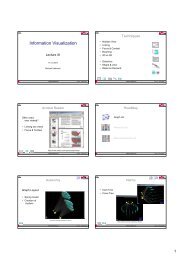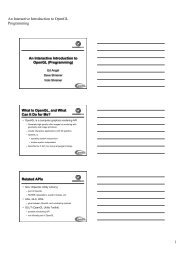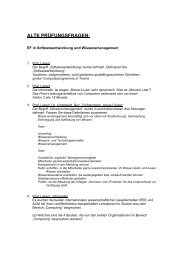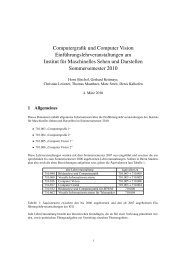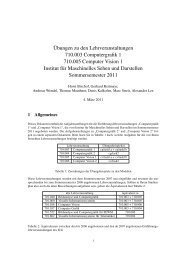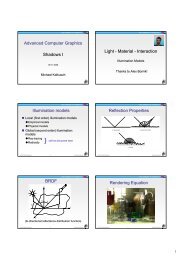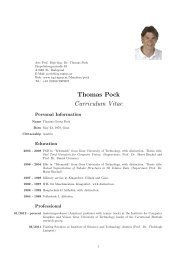Lehrveranstaltungsinhalt aus - Institute for Computer Graphics and ...
Lehrveranstaltungsinhalt aus - Institute for Computer Graphics and ...
Lehrveranstaltungsinhalt aus - Institute for Computer Graphics and ...
You also want an ePaper? Increase the reach of your titles
YUMPU automatically turns print PDFs into web optimized ePapers that Google loves.
0.5. GEOMETRIC DETAIL 13<br />
in the courtyards <strong>and</strong> so they shown black or grey here. When this occurs, the representation is<br />
without photographic texture, <strong>and</strong> is instead in the <strong>for</strong>m of a flat shaded representation.<br />
Slide 0.37 looks at the roof scape <strong>and</strong> we see that perhaps we should model the chimneys as shown<br />
here. However, the skylights were not modeled. What can we do with these data? We can walk or<br />
fly through the cities. We can assess changes <strong>for</strong> example by removing a building <strong>and</strong> replacing<br />
it by a new one. We call this “virtual reality”, but scientists often prefer the expression “virtual<br />
environment”, since “virtual” <strong>and</strong> “reality” represent a contradiction in terms. This differs of<br />
course from photographic reality, which is more detailed <strong>and</strong> more realistic by showing great<br />
geometric detail, showing wires, dirt on the road, cars, the effect of weather. There is yet another<br />
type of reality, namely “physical reality”, when we are out there in a city <strong>and</strong> we feel the wetness<br />
in our shoes, we feel the cold in the air, we hear the noise of birds, the screeching of cars. So we<br />
see various levels of reality: physical, photographic <strong>and</strong> virtual reality.<br />
0.5 Geometric Detail<br />
What geometric detail do we need when we model a city? Lets take the example of a roof. Slide<br />
0.44 is a roofshape extracted <strong>for</strong> the Vienna example, We have not applied to the roof photographic<br />
texture, but instead some generic computer texture. We will talk later of course about texture<br />
<strong>and</strong> I will try to explain different types of texture <strong>for</strong> use in rendering <strong>for</strong> computer graphics. If<br />
we apply this kind of generic texture we loose all in<strong>for</strong>mation about the specific characteristics<br />
of this roof. What we would like to have is the roof shown with chimneys. Maybe we need<br />
skylights as well far the fire-guard in order to direct people to an exit through the roof in the case<br />
of a catastrophy. There is a topic here <strong>for</strong> a Diplomarbeit <strong>and</strong> Dissertation theme to study the<br />
amount of geometric detail needed in the presence of photographic texture: the trade-off between<br />
photographic texture <strong>and</strong> geometry detail. To illustrate this further let us take a look at the same<br />
roof with its skylights <strong>and</strong> chimneys <strong>and</strong> now use photographic texture to illustrate how this roof<br />
looks like. If we take photographic texture, <strong>and</strong> if we have some chimneys, <strong>and</strong> if we render this<br />
roof from another perspective than that from which the photograph was taken, the chimneys will<br />
look very unnatural. So we need to do some work <strong>and</strong> create the geometric model of the chimneys.<br />
If we employ that model <strong>and</strong> we now superimpose the photographic texture over it, we see that<br />
we have sunshine casting shadows <strong>and</strong> we have certain areas of the roof that are covered by pixels<br />
from the shadows left by the chimneys. If the sunshine is from another side, say in the morning,<br />
but the picture was taken in the afternoon, we have wrong shadows. So we need to fix this by<br />
eliminating the shadows in the texture. We introduce the shadow in a proper rendering by a<br />
computation. We also need to fill in those pixels that are covered by the perspective distortion of<br />
the chimneys, <strong>and</strong> use generic pixels of the roof to fill in the areas where no picture exists. Slide<br />
0.50 is the final result: we have removed the shadow, we have filled in the pixels. We now have<br />
the best representation of that roof with its chimneys <strong>and</strong> we can render this now correctly in the<br />
morning <strong>and</strong> in the afternoon, with rain or with sunshine.<br />
0.6 Automation<br />
All of this modeling of cities is expensive, bec<strong>aus</strong>e it is based on manual work. In order to<br />
reduce the cost of creating such models one needs to automate their creation. Automation is a<br />
large topic <strong>and</strong> is available <strong>for</strong> many Diplomarbeiten <strong>and</strong> many Dissertations. Let me illustrate<br />
automation <strong>for</strong> about our city-models in Graz. There already exist 2-dimensional descriptions<br />
so the task of automating here is to achieve the transition from two to three dimensions. Slide<br />
0.52 is a two-dimensional so-called geographic in<strong>for</strong>mation system (GIS) of a certain area around<br />
the Schlossberg in Graz. Lets take a look at this particular building in Slide 0.53. We have a<br />
total of five aerial photographs, 3 of them are shown of that particular building in Slide 0.54.



